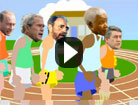I’m building the 60 Second Leader online community with my IT colleague Brom and we are trying to make it as participatory and co-creational as possible (co-creative? I prefer ‘co-creational’ as it has echoes of ‘creationism’ and therefore sounds more godlike, and the point is to let everyone do the creating -there is that of god in each of us, as the Quakers say).
But, this brings us up against the problem of participation literacy – I think a lot of people don’t get involved with Wikis and even multi-user blogs because they (like me, with Wikis) don’t really know instantly what to do.
And I/they don’t have the time or confidence to try learning-by-doing within a participatory site (though some of the newer Wiki software looks more like word processing software, so is more familiar than the techno-aware formats most of them are in).
This isn’t a new problem. Organizations that have tried to build Knowledge Management or knowledge exchange platforms within their corporation to get people to participate have built far more parties-that-no-one-comes-to than thriving centres of exchange. Though, that is partly a problem of centrism and diktat rather than literacy.
Anyway, our proposed solution at the moment is to offer a range of tools for the 60 Second Leader online commmunity to interact and participate with, such as
1. a Q & A function, using something like www.yedda.com if poss.
2. find-a-buddy with the same interests function for individual peer assists and peer mentoring and coaching, privately or sharing the outcomes/learning (hopefully the latter, with the confidential stuff kept out)
3. a multi-user blog to raise leadership issues and share insights and solutions
4. a ‘re-write the book of leadership’ wiki so participants can re-write the 60 Second Leader book as soon as it is published (April in the UK, June in the US) because they know more than me about leadership (I don’t believe in the possibility of expertise, least of all that I have any…)
5. A ‘set up a small group to find a solution to a problem, then disperse the group when you are happy, but don’t forget th share the solutions’ tool (I know: we need to find a better name than that for group peer assistance. Hey, maybe ‘group peer assistance’ then…
…and a few more ‘tools’ of participation and interaction and contribution. Some of these will be taken up. Others will languish and we will remove them. That process will be a form of ‘co-creation’ of the environment, as participants choose by use or omission what tools will form the environment.
Anyway, that’s where we are so far. Anyone out there who can help us improve this approach…your thoughts will be immensely useful.
I’ve built traditional websites the traditional way before – design brief, design agency, specify the architecture, specify the functionality, ask for a user experience (that you never get), road test it with some ‘users’ before going live etc…and the result was cr*p in both cases. A normal business to business website that was just like any other, in other words.
So, this time we are using this trial and error emergent process to let the shape of the thing emerge rather than prescribe or proscribe it in advance. Fingers crossed.
Some interesting thoughts on navigation and the idea of ‘flow’ or being in the zone on the Participation literacy website if you scroll down on it to the headline here
Flow: the link between existence and navigation.









Leave a Reply